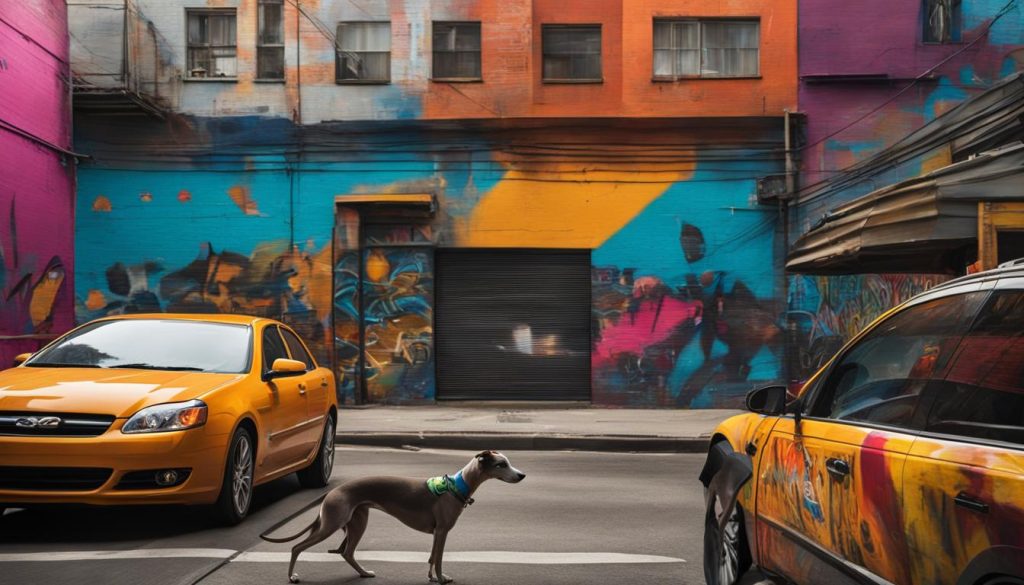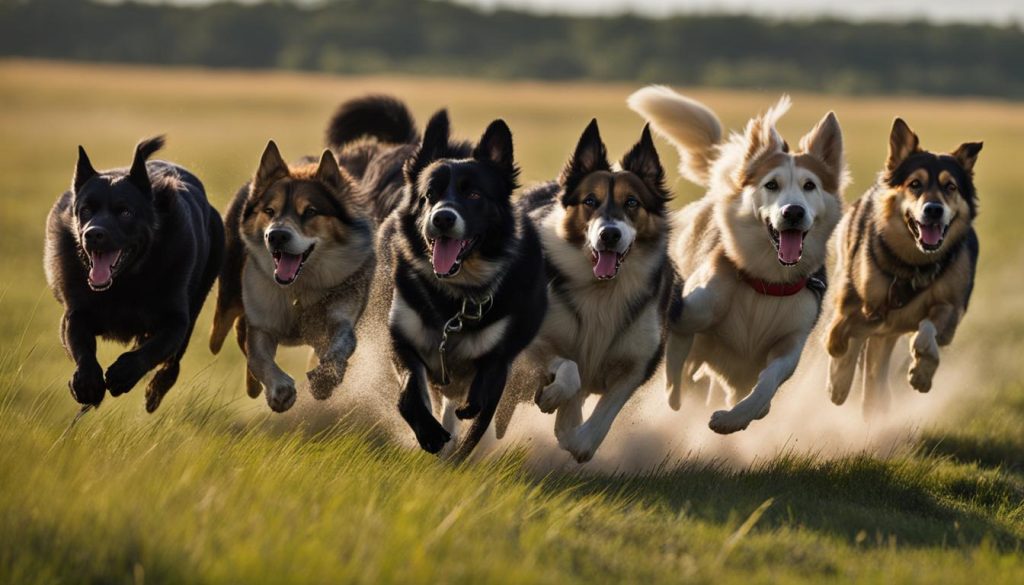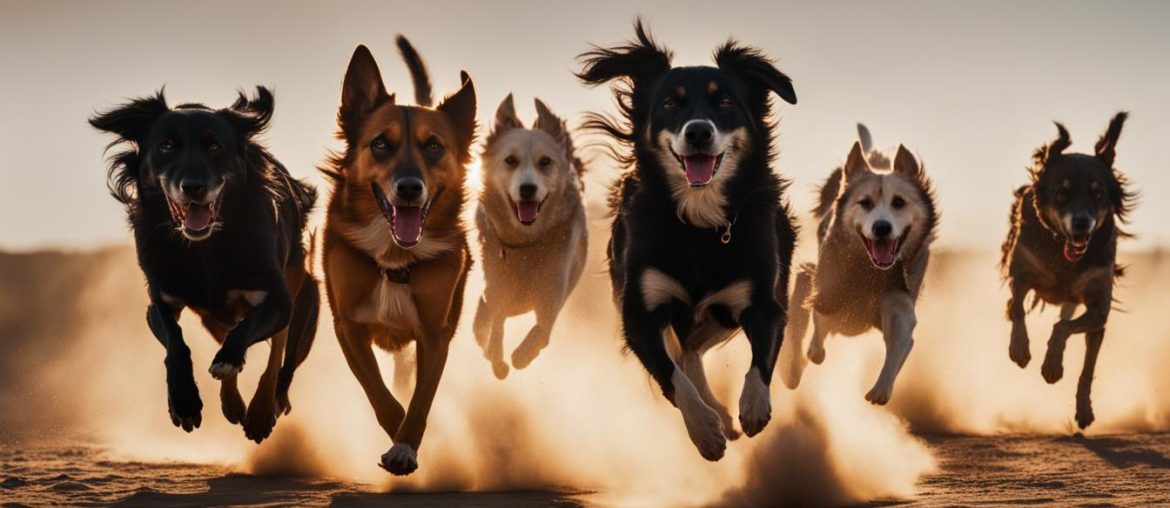Choosing the right dog breed for long-distance running is crucial to ensure a compatible running partner. While any dog can be trained to run, certain breeds are naturally more athletic and better suited for extended physical activity. In this article, we will explore the top dog breeds for long-distance running based on factual data and expert recommendations to help you find the perfect running companion for your goals.
Key Takeaways:
- Long-distance running requires a breed that is athletic and has the endurance to keep up with your pace.
- Border Collies, Australian Shepherds, and Cattle Dogs are excellent choices for trail running and mountain distances.
- Breeds like Vizslas and Weimaraners are well-suited for running in hot climates due to their short coats.
- German Shepherds and Golden Retrievers are highly adaptable and ideal for urban running.
- Pugs, Bulldogs, and French Bulldogs are prone to respiratory issues and may not be suitable for long-distance running.
The Best Breeds for Trail Running and Mountain Distances
If you’re a trail runner who enjoys challenging terrains and long distances in the mountains, you’ll need a breed that can handle the demands of such environments. Herding dogs like Border Collies, Australian Shepherds, and Cattle Dogs are bred to handle long distances and are well-suited for trail running. These breeds have the endurance and athleticism to keep up with the rigors of trail running and mountain distances.
German Short-Haired Pointers and Vizslas are also great choices for trail runners. These breeds excel at both speed and endurance, making them ideal companions for those who enjoy trail running in mountainous areas. Their muscular build and high energy levels enable them to navigate steep inclines and challenging terrains with ease.
| Breed | Description |
|---|---|
| Border Collie | A highly intelligent and energetic breed known for their exceptional endurance and agility. They excel at herding and make excellent trail running companions. |
| Australian Shepherd | An athletic and versatile breed with a strong herding instinct. They have the stamina and agility to handle long distances and varied terrains. |
| Cattle Dog | A robust and agile breed originally bred for herding cattle. They are known for their endurance and ability to handle challenging terrains. |
| German Short-Haired Pointer | A versatile hunting breed known for their athleticism and stamina. They have the speed and endurance to keep up with trail runners in mountainous areas. |
| Vizsla | An energetic and athletic breed that excels in various dog sports. They have the endurance to tackle long distances and the agility to navigate rugged terrains. |
When trail running and conquering mountain distances, I would advise that you have a canine companion that can match your pace and endurance. Choose a breed that is well-suited for such activities and ensure you provide them with proper training and care to keep them healthy and happy on the trails.

The Importance of Proper Training and Conditioning
Before embarking on trail running or mountain distances with your dog, please invest time and effort into their training and conditioning. This will not only ensure their safety and well-being but also enhance their performance on the trails.
- Gradually increase the distance and intensity of your runs to build your dog’s endurance over time.
- Focus on obedience training to ensure your dog listens to your commands and stays on the trail.
- Introduce your dog to different terrains and surfaces to acclimate them to the challenges they may encounter during trail running.
- Pay attention to your dog’s hydration needs and carry enough water for both of you during your runs.
- Monitor your dog’s behavior and condition closely during and after your runs to detect any signs of fatigue or injury.
Proper training and conditioning are essential for you and your dog’s safety and enjoyment during trail running and mountain distances. Take the time to prepare both mentally and physically, ensuring you have a positive and rewarding experience on the trails.
Trail running and conquering mountain distances with your dog can be a fulfilling and exhilarating experience. The bond you build with your canine companion as you explore breathtaking trails and overcome challenging terrains is truly special. Choose a breed that is well-suited for such activities, invest in their training and conditioning, and embark on memorable adventures together.
Breeds for Moderate Distances and Varied Terrains
If your running distances max out at 3-5 miles and you prefer a mix of terrains, there are breeds that excel in these conditions. Snub-nosed mixes, some terriers, and larger breeds like Bernese Mountain Dogs are well-suited for moderate distances and varied terrains. These breeds can handle different surfaces and provide a good balance of energy and endurance for shorter runs.
Breeds for Moderate Distances and Varied Terrains
When it comes to running moderate distances in a variety of terrains, choose a breed that can handle the different challenges that may arise. Snub-nosed mixes, such as Boxer mixes, can be great companions for moderate distance running. These breeds have a good balance of energy and endurance, and their compact size makes them agile on different surfaces. Some terrier breeds, like Jack Russell Terriers, are also well-suited for moderate distances and varied terrains. They have a high energy level and are known for their agility, making them excellent running partners.
For those who prefer larger breeds, Bernese Mountain Dogs are a great option for moderate distance running. Despite their size, they are surprisingly adaptable and can handle various terrains with ease. Their thick coats provide insulation and protection in different weather conditions, making them suitable for running in both hot and cold climates. Bernese Mountain Dogs are known for their friendly and gentle nature, making them ideal companions for long-distance running.
Choosing a breed that is well-suited for moderate distances and varied terrains will ensure that you have a reliable and capable running partner. Whether it’s a snub-nosed mix, a terrier, or a larger breed like the Bernese Mountain Dog, finding a breed that matches your running style and preferences is key to enjoying your runs to the fullest.
Cold Weather Running Companions
When it comes to running in cold weather, having a breed that can withstand the low temperatures is essential. Certain athletic dog breeds are well-suited for long-distance running in snowy or icy conditions due to their natural endurance and ability to handle cold weather. Siberian Huskies and Alaskan Malamutes are two breeds known for their cold-weather running capabilities.
These breeds were originally bred for pulling sleds over long distances, making them excellent companions for cold weather running. They have thick double coats that provide insulation and protection against the cold. This allows them to comfortably endure outdoor exercise even in freezing temperatures.
“Siberian Huskies and Alaskan Malamutes have the physical attributes and stamina required for long-distance running in cold weather. Their endurance, coupled with their thick coats, make them ideal companions for runners who enjoy outdoor activities in cold climates.”
while these breeds excel in cold weather running, proper precautions should still be taken to ensure the safety and well-being of your running companion. This includes monitoring their paws for signs of frostbite, providing sufficient hydration, and avoiding extreme weather conditions when necessary.
Finding the Right Balance
When choosing a dog breed for cold weather running, find a balance between endurance and cold tolerance. While Siberian Huskies and Alaskan Malamutes are well-suited for extremely cold conditions, other athletic breeds with shorter coats can also handle moderately cold temperatures.
For example, breeds like the German Shorthaired Pointer and the Weimaraner have less insulation in their coats but are still capable of running in cold weather. These breeds have high energy levels and endurance, making them suitable companions for long-distance running in moderately cold climates.
Ultimately, the ideal cold weather running companion will depend on the specific conditions and temperature range in which you plan to run. Consulting with experts or experienced runners can provide valuable insights and guidance in selecting the breed that is best suited for your cold weather running adventures.
Running in Hot Climates
When it comes to running in hot climates, consider the impact of high temperatures on your dog’s health. Not all dog breeds are well-suited for hot weather conditions, as they may struggle to regulate their body temperature effectively. However, certain athletic and endurance dog breeds are better equipped to handle the heat.
Key Considerations for Running in Hot Climates:
- Choose athletic dog breeds with short coats, as they are more heat-tolerant.
- Monitor your dog closely for signs of overheating, such as excessive panting, drooling, or lethargy.
- Plan your runs during cooler parts of the day, such as early mornings or evenings.
- Provide access to fresh water before, during, and after your run to keep your dog properly hydrated.
- Avoid running on hot surfaces like asphalt, as they can burn your dog’s paws.
Running in hot climates requires extra precautions to ensure the well-being of your dog. I highly suggest that you pay attention to their comfort and safety by following these guidelines.

| Breed | Key Features |
|---|---|
| Vizsla | Athletic, short coat, heat-tolerant |
| Weimaraner | Endurance, short coat, heat-tolerant |
| Italian Greyhound | Lightweight, short coat, heat-tolerant |
These athletic dog breeds, such as Vizslas, Weimaraners, and Italian Greyhounds, have short coats that help them dissipate heat more efficiently. They can handle running in hot climates with proper care, but it’s vital to be mindful of their well-being throughout the run.
Note: Always consult with your veterinarian before embarking on long-distance running in hot climates to ensure your dog’s health and safety.
Best Breeds for Urban Running
Urban running is a unique experience that requires a dog breed that can navigate busy streets and handle the challenges of an urban environment. When running in the city, I would advise that you choose a breed that can cope with the noise, crowds, and various surfaces commonly encountered in urban areas. Here are some athletic dog breeds that excel in urban running:
- German Shepherds
- Golden Retrievers
- Border Collies
- Australian Shepherds
These breeds are highly intelligent, adaptable, and energetic, making them ideal companions for urban runners. Their versatility allows them to adjust to different terrains and handle the distractions of the urban environment with ease. Whether you’re running through city parks or along busy streets, these breeds will keep up with your pace and enjoy the adventure of urban running.
When engaging in urban running, prioritize the safety of yourself and your dog. Always keep your dog on a leash and follow local regulations regarding dogs in public areas. Be aware of potential hazards such as traffic, pedestrians, and other dogs. Additionally, ensure that your dog is properly trained and responds to commands to mitigate any potential risks while running in the urban landscape.
| Breed | Characteristics |
|---|---|
| German Shepherd | Intelligent, loyal, and adaptable. Excellent endurance and agility. |
| Golden Retriever | Friendly, trainable, and energetic. Known for their athletic abilities. |
| Border Collie | Highly intelligent, agile, and responsive. Thrives in active environments. |
| Australian Shepherd | Energetic, versatile, and attentive. Well-suited for various physical activities. |
Don’t forget that each dog is an individual, and their fitness levels and abilities can vary. When choosing a breed for urban running, consider your dog’s temperament, energy levels, and overall health to ensure a successful running partnership. Taking the time to train, prepare, and select the right breed will result in a rewarding and enjoyable urban running experience for both you and your furry companion.

Running Safely in Urban Environments
When running with your dog in urban areas, follow some safety guidelines to ensure the well-being of both you and your canine companion:
- Choose well-lit routes and avoid running during peak traffic hours to minimize potential hazards.
- Use a sturdy leash and harness to maintain control and prevent your dog from darting into traffic or getting lost.
- Stay hydrated and bring water for your dog to ensure they stay hydrated too.
- Be mindful of the temperature and avoid running on hot pavement to prevent paw pad burns.
- Pay attention to your surroundings and potential hazards such as broken glass, debris, or other hazards that could injure your dog.
“Urban running with a well-trained and compatible dog breed can be a fantastic way to stay fit and explore your city together!”
Avoiding Breeds with Respiratory Issues
When it comes to choosing a dog breed for long-distance running, considering their respiratory health is crucial. Certain breeds with shorter noses, such as Pugs, Bulldogs, and French Bulldogs, are prone to respiratory issues that can severely impact their ability to handle high-intensity exercise. These breeds have what is known as brachycephalic syndrome, characterized by narrowed airways and difficulty breathing.
Running, especially for extended periods or in hotter climates, can put additional stress on their already compromised respiratory systems. Engaging in long-distance running with these breeds can lead to overheating, exhaustion, and potentially life-threatening situations. I would recommend to prioritize the health and well-being of your running companion by choosing a breed that is not predisposed to respiratory issues.
The negative impacts of brachycephalic syndrome on a dog’s ability to engage in long-distance running are due to their anatomy. Their shortened airways restrict the airflow, making it difficult for them to take in enough oxygen and exhale carbon dioxide efficiently. This limitation can lead to labored breathing, fatigue, and even collapse during physically demanding activities.

Training and Preparation for Long-Distance Running with Dogs
When it comes to long-distance running with dogs, proper training and preparation are essential for a successful and enjoyable experience. Whether you have an athletic dog breed or a fitness-oriented dog, these tips will help you and your furry companion get ready for those challenging runs.
Gradual Training
Building up your dog’s endurance gradually is crucial to prevent injuries and overexertion. Start with shorter distances and gradually increase the mileage over time. Pay attention to your dog’s cues and adjust the training accordingly. I recommend that you give your dog enough time to rest and recover between runs to avoid burnout.
Mental Stimulation
Keep your dog mentally engaged during runs by providing mental stimulation. Incorporate commands, obstacles, and interactive toys during your training sessions. This not only keeps your dog focused but also adds an extra element of fun to your runs. Mental stimulation is just as important as physical exercise for a well-rounded running companion.
Proper Gear
Equipping your dog with the right gear is crucial for their comfort and safety during long-distance runs. Invest in a well-fitting harness that allows your dog to move freely. Consider using a hands-free leash that attaches to a waist belt to ensure a comfortable and stable running experience. Additionally, protect your dog’s paws with suitable footwear to prevent injuries on rough terrains. Don’t forget to carry water and treats to keep your dog hydrated and fueled during the run.

Consistency and Variety
Consistency is key in training your dog for long-distance running. Stick to a regular running schedule to build stamina and endurance. However, it’s also important to vary your running routes to keep your dog mentally stimulated and prevent boredom. Exploring new environments and terrains will challenge your dog both physically and mentally, making them a well-rounded running companion.
By following these training and preparation guidelines, you and your four-legged friend will be ready to hit the trails or conquer those long-distance runs together. Try to always prioritize your dog’s well-being and adjust your training plan based on their individual needs. With the right training, you’ll have a loyal and energetic running companion by your side for many miles to come.
Considerations for Running in Wildlife Areas
Running in wildlife areas can be a thrilling experience, but take certain considerations into account to ensure the safety of both you and your dog, as well as the local wildlife. Dogs with high prey drives, such as Siberian Huskies and hunting breeds like Pointers, may be more prone to getting distracted by wildlife during runs. I highly suggest that you train your dog to stay focused on you and follow your commands, even in the presence of wildlife. This not only prevents disruptions to local ecosystems but also helps keep your dog safe from potential encounters with wild animals.
Respecting the natural habitat is essential when running in wildlife areas. Be mindful of any local regulations or guidelines that are in place to protect the environment and wildlife. Stick to designated trails and avoid venturing off into sensitive areas that could disturb nesting grounds or habitats. By being a responsible runner, you can help preserve the natural beauty of these areas and ensure that they can continue to be enjoyed by future generations.

Protective Gear and Precautions
When running in wildlife areas, take extra precautions to keep both you and your dog safe. Here are some essential protective gear and measures to consider:
- Leash: Ensure that your dog is always on a leash to maintain control and prevent them from chasing or approaching wildlife.
- Bear Bells: In areas with larger wildlife, it can be helpful to attach bear bells to your dog’s collar or leash to alert animals of your presence.
- Muzzles: If you have a breed with a high prey drive or your dog has shown aggression towards wildlife in the past, a muzzle may be necessary for added safety.
- Tick and Flea Prevention: Wildlife areas are often home to ticks and fleas, so make sure your dog is protected with appropriate preventive measures.
By being aware of your surroundings, respecting wildlife and their habitat, and taking necessary precautions, you can enjoy running in wildlife areas while minimizing any negative impact and ensuring the safety of everyone involved.
Choosing the Right Dog for Your Running Lifestyle
When it comes to finding the perfect dog breed for your long-distance running adventures, there are several factors to consider. Your personal running preferences and lifestyle play a significant role in determining the most suitable athletic companion. Here are some key points to keep in mind:
Energy Levels and Fitness
Long-distance running requires dogs with high energy levels and excellent fitness. Look for breeds known for their endurance and athleticism, such as Vizslas, Border Collies, German Shepherds, and Siberian Huskies. These breeds thrive on physical activity and can keep up with your running routine.
Build and Physical Characteristics
The build and physical characteristics of a dog breed can also impact their suitability for long-distance running. Consider breeds with lean and muscular bodies, as they are built for sustained physical activity. Dogs with longer legs and a moderate body size are often agile and well-suited for running.
Temperament and Trainability
Choosing a dog with the right temperament and trainability is essential for a successful running partnership. Look for breeds that are known for their focus, obedience, and desire to please their owners. Training and socialization are crucial to ensure your running companion follows your commands and remains focused during runs.
| Energy Levels | Build | Temperament | Examples of Suitable Breeds |
|---|---|---|---|
| High | Lean and Muscular | Focused and Obedient | Vizslas, Border Collies |
| Moderate | Moderate Body Size | Agile and Intelligent | German Shepherds, Siberian Huskies |
| High | Lean and Muscular | Focused and Obedient | Vizslas, Border Collies |
Don’t forget that individual dogs within a breed can vary in their fitness levels and abilities. Take the time to assess each dog’s temperament, energy levels, and overall health before making a decision. Consulting with experienced runners or breeders can provide valuable insights into a specific breed’s suitability for long-distance running. With thorough research and consideration, you can find the perfect running partner to join you on your fitness journey.

To sum it up, choosing the right dog for your running lifestyle involves considering energy levels, build, temperament, and trainability. You should also select a breed known for endurance, agility, and suitability for physical activity. Keep in mind that individual dogs within a breed can vary, so careful evaluation of each dog’s fitness and characteristics is necessary. By finding the ideal running companion, you can enjoy long-distance adventures with a loyal and energetic partner by your side.
Final Thoughts
To sum it up, when it comes to finding the perfect long-distance running dog breed, there are several factors to consider. The breeds mentioned in this article, such as Vizslas, Border Collies, German Shepherds, and Siberian Huskies, are known for their endurance and athleticism, making them excellent choices for long-distance running. These breeds possess the energy levels, build, and coat types that are well-suited for extended physical activity.
However, remember that individual dogs within a breed can vary in their fitness levels and abilities. Therefore, careful evaluation of each dog’s temperament, energy levels, and overall health is crucial in determining their suitability for running. Conducting research, seeking advice from experienced runners or breeders, and assessing each dog’s specific characteristics can help you make an informed decision.
With proper training, preparation, and attention to your dog’s needs, you can have a loyal and energetic running companion to join you on your long-distance adventures. Whether you prefer trail running, urban running, or running in specific climatic conditions, there is a breed out there that will be the perfect match for your running lifestyle.
So, take your time, consider your running goals and preferences, and choose a long-distance running dog breed that will not only keep pace with you but also bring joy and companionship to your running journeys.
FAQ
What are the best dog breeds for long-distance running?
The top dog breeds for long-distance running include Border Collies, Australian Shepherds, Cattle Dogs, German Short-Haired Pointers, and Vizslas, among others.
Which dog breeds are suitable for trail running and mountain distances?
Breeds such as Border Collies, Australian Shepherds, Cattle Dogs, German Short-Haired Pointers, and Vizslas are well-suited for trail running and mountain distances.
What dog breeds are good for moderate distances and varied terrains?
Dogs like snub-nosed mixes, some terriers, and larger breeds like Bernese Mountain Dogs are suitable for moderate distances and varied terrains.
Which breeds are built for running in cold weather?
Northern breeds like Siberian Huskies and Alaskan Malamutes are naturally bred for endurance in cold weather and are ideal for long-distance running in snowy or icy conditions.
What breeds are suitable for running in hot climates?
Breeds such as Vizslas and Weimaraners, with short coats and the ability to handle warmer temperatures, are well-suited for running in hot climates.
Which breeds are best for urban running?
German Shepherds and Golden Retrievers are highly intelligent and adaptable breeds that are ideal for running in urban environments.
Should I avoid certain breeds with respiratory issues for long-distance running?
Yes, breeds with shorter noses like Pugs, Bulldogs, and French Bulldogs are prone to respiratory issues and may not be suitable for long-distance running.
What training and preparation is necessary for long-distance running with dogs?
Gradually increasing distance and intensity, providing proper training and mental stimulation, and equipping dogs with necessary gear are crucial for successful long-distance running.
How should I approach running in wildlife areas with my dog?
Breeds with high prey drives should be trained to stay focused, and precautions should be taken to ensure the safety of your dog and the local wildlife when running in wildlife areas.
What factors should I consider when choosing the right dog for my running lifestyle?
Factors to consider include preferred running distances, terrains, climatic conditions, and evaluating each dog’s temperament, energy levels, and overall health.






